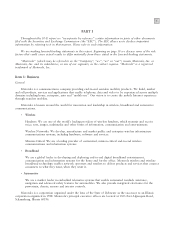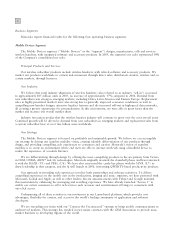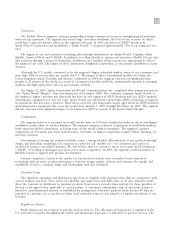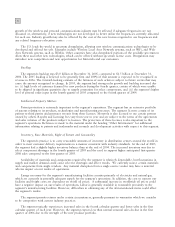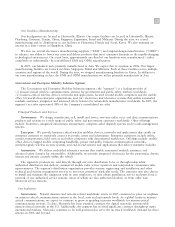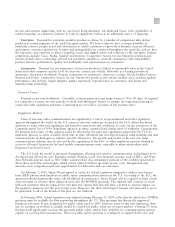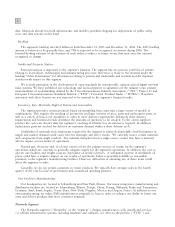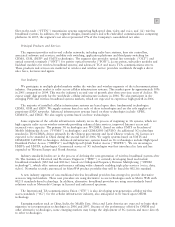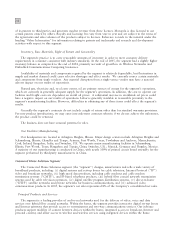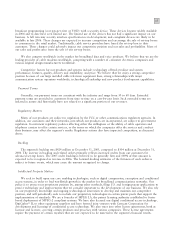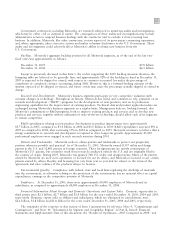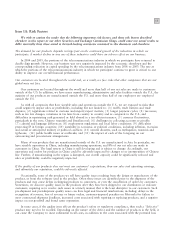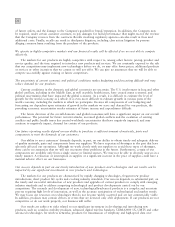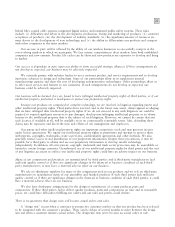Motorola 2005 Annual Report Download - page 18
Download and view the complete annual report
Please find page 18 of the 2005 Motorola annual report below. You can navigate through the pages in the report by either clicking on the pages listed below, or by using the keyword search tool below to find specific information within the annual report.
11
Sprint Nextel is our largest customer, representing 25% of the segment's net sales in 2005. On August 12, 2005,
Sprint Corporation and Nextel Communications, Inc. completed their merger transaction (the ""Sprint Nextel
Merger'') that was announced in December 2004. The combined company, Sprint Nextel, is the segment's largest
customer and Motorola has been its sole supplier of iDEN handsets and core iDEN network infrastructure
equipment for over ten years. Sprint Nextel uses Motorola's proprietary iDEN technology to support its nationwide
wireless service business. Motorola is currently operating under supply agreements for iDEN handsets and
infrastructure equipment that cover the period from January 1, 2005 through December 31, 2007. The segment did
not experience any significant impact to its business in 2005 as a result of the Sprint Nextel Merger.
Competition
Networks experiences competition in worldwide markets from numerous competitors, ranging in size from
some of the world's largest companies to small specialized firms. In the cellular infrastructure industry, Ericsson is
the market leader, followed by Nokia and four vendors with similar market share positions, including Motorola,
Siemens, Lucent and Nortel. Alcatel, Samsung and NEC are also significant competitors. We also experience price
competition for both 2G and 3G systems from Chinese vendors, such as Huawei and ZTE.
Competitive factors in the market for the segment's products include: technology offered; price; payment
terms; availability of vendor financing; product and system performance; product features, quality, delivery,
availability and warranty; the quality and availability of service; company image; relationship with key customers;
and time-to-market. Price is a major area of competition and often impacts margins for initial system bids,
particularly in emerging markets. Time-to-market has also been an important competitive factor, especially for new
systems and technologies.
Payment Terms
The segment's contracts typically include implementation milestones, such as delivery, installation and system
acceptance. Generally, these milestones can take anywhere from 30 to 180 days to complete. Customer payments
are typically tied to the completion of these milestones. Once a milestone is reached, payment terms are generally
30 to 60 days. As required for competitive reasons, we may arrange or provide for extended payment terms or long-
term financing.
Regulatory Matters
Radio frequencies are required to provide wireless services. The allocation of frequencies is regulated in the
U.S. and other countries throughout the world, and limited spectrum space is allocated to wireless services. The
growth of the wireless and personal communications industry may be affected if adequate frequencies are not
allocated or, alternatively, if new technologies are not developed to better utilize the frequencies currently allocated
for such use. Industry growth may also be affected by the cost of the new licenses required to use frequencies and
any related frequency relocation costs.
The U.S. leads the world in spectrum deregulation, allowing new wireless communications technologies to be
developed and offered for sale. Examples include Wireless Local Area Network systems, such as WiFi, and Wide
Area Network systems, such as Wi4. Other countries have also deregulated portions of the available spectrum to
allow for new technologies, which can be offered without spectrum license costs. Deregulation may introduce new
competition and new opportunities for Motorola and our customers.
Backlog
The segment's backlog was $2.0 billion at both December 31, 2005 and December 31, 2004. The 2005 order
backlog is believed to be generally firm and 100% of that amount is expected to be recognized as revenue during
2006. The forward-looking estimate of the firmness of such orders is subject to future events that may cause the
amount recognized to change.
Intellectual Property Matters
Patent protection is extremely important to the segment's operations. The segment has an extensive portfolio
of patents relating to its products, systems, technologies and manufacturing processes. The segment licenses certain


